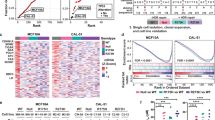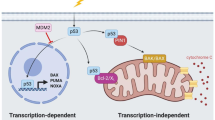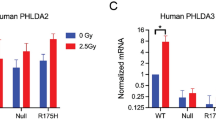Abstract
p53 is one of the most important tumor suppressor genes in human cancer, but the roles of its homologues p63 and p73 in tumor suppression, alone or in collaboration with p53, remains controversial. Both p63 and p73 can be deregulated after DNA damage, and induce cell cycle arrest and apoptosis, but mice carrying inactive alleles of these genes do not develop spontaneous tumors. Since heterozygous loss of p53 confers strong sensitization to radiation-induced lymphoma development, we investigated the possibility that radiation exposure may reveal previously undetected tumor suppressor properties in p63 or p73, alone or in combination with p53. Animals heterozygous for p63 or p73, as well as both double heterozygous p53/p63 or p53/p73 mice, showed no significant differences in tumor latency, spectrum or frequency after gamma-radiation, compared to their control counterparts. Deletions were found near the p63 locus on chromosome 16 in radiation-induced tumors, but these frequently included the knockout allele. No deletions or LOH involving the p73 gene were detected, and expression of both genes was maintained in the tumors. We conclude that p53 homologues do not contribute to p53 tumor suppressor activity in lymphoma development.
This is a preview of subscription content, access via your institution
Access options
Subscribe to this journal
Receive 50 print issues and online access
$259.00 per year
only $5.18 per issue
Buy this article
- Purchase on Springer Link
- Instant access to full article PDF
Prices may be subject to local taxes which are calculated during checkout




Similar content being viewed by others
References
Agami R, Blandino G, Oren M and Shaul Y . (1999). Nature, 399, 809–813.
Cai WW, Mao JH, Chow CW, Damani S, Balmain A and Bradley A . (2002). Nat. Biotechnol., 20, 393–396.
Crook T, Nicholls JM, Brooks L, O'Nions J and Allday MJ . (2000). Oncogene, 19, 3439–3444.
Dohn M, Zhang S and Chen X . (2001). Oncogene, 20, 3193–3205.
Flores ER, Tsai KY, Crowley D, Sengupta S, Yang A, McKeon F and Jacks T . (2002). Nature., 416, 560–564.
Gong JG, Costanzo A, Yang HQ, Melino G, Kaelin Jr WG, Levrero M and Wang JY . (1999). Nature, 399, 806–809.
Hibi K, Trink B, Patturajan M, Westra WH, Caballero OL, Hill DE, Ratovitski EA, Jen J and Sidransky D . (2000). Proc. Natl. Acad. Sci. USA, 97, 5462–5467.
Jost CA, Marin MC and Kaelin Jr WG . (1997). Nature, 389, 191–194.
Kemp CJ, Wheldon T and Balmain A . (1994). Nat. Genet., 8, 66–69.
Lang GA, Iwakuma T, Suh YA, Liu G, Rao VA, Parant JM, Valentin-Vega YA, Terzian T, Caldwell LC, Strong LC, El-Naggar AK and Lozano G . (2004). Cell., 119, 861–872.
Liefer KM, Koster MI, Wang XJ, Yang A, McKeon F and Roop DR . (2000). Cancer Res., 60, 4016–4020.
Mao JH, Perez-Losada J, Wu D, Delrosario R, Tsunematsu R, Nakayama KI, Brown K, Bryson S and Balmain A . (2004). Nature, 432, 775–779.
Marin MC, Jost CA, Irwin MS, DeCaprio JA, Caput D and Kaelin Jr WG . (1998). Mol. Cell. Biol., 18, 6316–6324.
Mills AA, Zheng B, Wang XJ, Vogel H, Roop DR and Bradley A . (1999). Nature, 398, 708–713.
Olive KP, Tuveson DA, Ruhe ZC, Yin B, Willis NA, Bronson RT, Crowley D and Jacks T . (2004). Cell., 119, 847–860.
Olivier M, Eeles R, Hollstein M, Khan MA, Harris CC and Hainaut P . (2002). Hum. Mutat., 19, 607–614.
Park JJ, Sun D, Quade BJ, Flynn C, Sheets EE, Yang A, McKeon F and Crum CP . (2000). Am. J. Surg. Pathol., 24, 1414–1419.
Senoo M, Manis JP, Alt FW and McKeon F . (2004). Cancer Cell., 6, 85–89.
Stiewe T and Putzer BM . (2002). Cell Death Differ., 9, 237–245.
Stiewe T, Theseling CC and Putzer BM . (2002). J. Biol. Chem., 277, 14177–14185.
Yang A, Kaghad M, Wang Y, Gillett E, Fleming MD, Dotsch V, Andrews NC, Caput D and McKeon F . (1998). Mol. Cell., 2, 305–316.
Yang A, Schweitzer R, Sun D, Kaghad M, Walker N, Bronson RT, Tabin C, Sharpe A, Caput D, Crum C and McKeon F . (1999). Nature, 398, 714–718.
Yang A, Walker N, Bronson R, Kaghad M, Oosterwegel M, Bonnin J, Vagner C, Bonnet H, Dikkes P, Sharpe A, McKeon F and Caput D . (2000). Nature, 404, 99–103.
Yuan ZM, Shioya H, Ishiko T, Sun X, Gu J, Huang YY, Lu H, Kharbanda S, Weichselbaum R and Kufe D . (1999). Nature, 399, 814–817.
Zaika AI, Kovalev S, Marchenko ND and Moll UM . (1999). Cancer Res., 59, 3257–3263.
Acknowledgements
We thank Dr Allan Bradley (The Welcome Trust Sanger Institute, UK) and Dr Alea Mills (CSHL) for the p63 knockout mice, and Dr Frank McKeon (Department of Cell Biology, Harvard Medical School, USA) for the p73 knockout mice; the UCSF animal house staff for help with mice husbandry. This work was supported by grants from the NCI (U01 CA84244) and the DOE (DE-FG02-03ER63630). AB acknowledges support from the Barbara Bass Bakar Chair of Cancer Genetics.
Author information
Authors and Affiliations
Corresponding authors
Rights and permissions
About this article
Cite this article
Perez-Losada, J., Wu, D., DelRosario, R. et al. p63 and p73 do not contribute to p53-mediated lymphoma suppressor activity in vivo. Oncogene 24, 5521–5524 (2005). https://doi.org/10.1038/sj.onc.1208799
Received:
Revised:
Accepted:
Published:
Issue Date:
DOI: https://doi.org/10.1038/sj.onc.1208799
Keywords
This article is cited by
-
p63 is required beside p53 for PERP-mediated apoptosis in uveal melanoma
British Journal of Cancer (2016)
-
The α/β carboxy-terminal domains of p63 are required for skin and limb development. New insights from the Brdm2 mouse which is not a complete p63 knockout but expresses p63 γ-like proteins
Cell Death & Differentiation (2009)
-
The F-box protein FBXO45 promotes the proteasome-dependent degradation of p73
Oncogene (2009)



